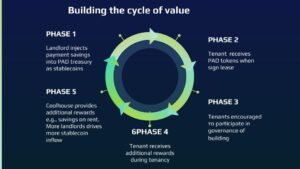Using digital assets in the SFR Real Estate market.


Introduction
RPL is a consultancy that specialises in the use of DLT in the Real Estate Sector. We manage a research consortium at the Bartlett School of Sustainable Construction which is called ‘Digital Disruption at UCL’ that has conducted workshops and research into the use of data to automate improvements to ESG characteristics and safety of Real Estate.
PIM – Project information Modelling
RPL worked with UCL Estates to design a platform which it calls PIM which stands for Project Information Modelling. This is a method of capturing and verifiying critical data through the construction phase of a building. In principle the system uses a gateway method of project management and gains the agreement of all parties that the data set is accurate and complete at the conclusion of the construction phase.
The pilot was conducted at the UCL PEARL laboratory construction project that was completed in 2021.

Stage two of PIM is to extend the use of DLT technology to the collection and verification of current data in the building, so that it can be relied upon by third parties and used to automate improvement. For example, research has shown that owners of large property portfolios can not look at their entire estate to demonstrate that their fire safety certificates have been obtained and are up to date. The use of PIM over the portfolio will give Estate owners a unique ability to view and search across a reliable, current and verified data set which can be used for management decision making.
Research conducted by the consortium found that despite the introduction of the Building Safety Bill 2022 which will introduce severe penalties for owners of buildings who do not introduce Fire Safety and other regulatory procedures, the need to introduce systems such as PIM is not currently sufficiently acute for Landlords to adopt new technologies in the near term.
The SFR Market
In 2021 RPL conducted a workshop entitled DeFi for Real Estate: The Mechanics of Decentralised Trust which explored the potential for use of Web 3 technologies in the Real Estate market, which is the second largest global market behind FinTech, but currently has little or no traction.
A single-family home is a property built (or existing) for the rental market to service families or individuals looking for additional space or specific home needs. It is a form of build-to-rent (BtR) that focuses on 30 to 45 year olds with young families. It is tailored more to the needs of this customer base, unlike most BtR multi-family housing (MFH) flats that appeal to singles and young professional couples.
Nuveen, who are one of the main sponsors of the Digital Disruption conclude in their recent report
‘Changing consumer preferences and working habits post pandemic have spurred interest in SFH. While still a nascent sector in the U.K. and the rest of Europe, the success of the concept in the U.S. implies it could quickly evolve into an institutional asset class.’
The conclusion of the workshop was that there is great potential for use of the wide ranging distributed technologies in this market. Real Estate capital is currently managed in large unwieldly funds which deal in the sale and development of substantial assets. It is clear that if the large pools of institutional capital that are now forming in the digital asset space can be deployed in the global Real Estate sector then a major realignment will occur.
In order to break into this market, RPL concluded that the sector that shows most promise is the SFR [Single Family Residence] or Buy To Rent market as it is being known in the UK.
The PAD token
RPL have therefore concluded from extensive research that there needs to be a ‘carrot and stick’ approach to the collection of critical safety and ESG data. Financial incentives need to be awarded to tenants, contractors and engineers and a mechanism designed to make it simple to upload critical data by means of a mobile phone ‘app’.
RPL will introduce the PAD token, which is funded by savings generated by the use of digital assets by foreign students to pay rent in the building rather than the use of credit cards, thus creating a token reward pool that can be used to reward good behaviours. For example, tenants who pay on time, participate in projects to improve the environmental characteristics of the development and agree to allow their data to be collected and analyised can build their own ‘renter profile’ which can help them when they move on to new buildings in the future.
The collection of data allows the Landlord to view the entire dataset to see for example the entire maintenance record of each flat in a development and make appropriate management decisions. It is also anticipated that critical energy use data can be collected by the introduction of IOT devices so that modelling can be conducted to improve performance of the building.
This process creates a cycle of value where the collection of data facilitates the ability of the property owner to improve the safety, ESG chacateristics and the actual value of the asset.
